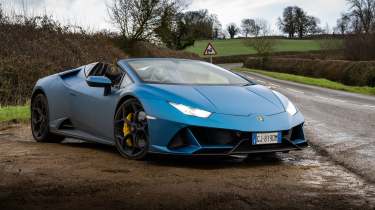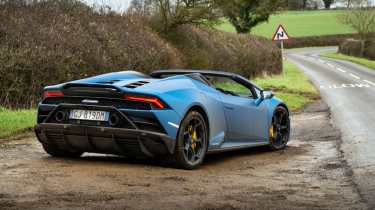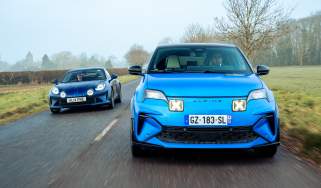Lamborghini Huracán Evo Spyder Fast Fleet test – six months in the V10 drop-top
After six months and nearly 6000 miles, time with our V10 ‘daily’ is up. These were the highs and lows
This is the end, not only for our Huracán Spyder on the Fast Fleet, but also for its spine-tingling, eardrum-bursting, borderline-antisocial yet totally endearing, exciting and heroic V10 appearing in a production car. In terms of series-production Huracáns, the Evo models – coupe, Spyder and Tecnica – are the end of the road, with the V8 hybrid Temerario taking their place.
Our Spyder arrived in the midst of winter. Not the perfect time for a soft-top Italian supercar, although its four-wheel drive provided some safety net. If only the car hadn’t been fitted with Pirelli P Zero Corsa rubber… Said tyres coped admirably well with the slimy conditions our winter served up, mind, finding traction when you expected a clumsy slip, clawing for grip when you knew you’d been greedy and asked too much of everything.
> The Lamborghini Temerario is a 10,000rpm V8 Huracán successor with hypercar power
A technical war chest of electronic all-wheel drive, active all-wheel steering and Lamborghini’s Integrated Vehicle Dynamics (LDVI) underpinned it all, and while these systems were unobtrusive, they offered more in terms of security than upping the engagement and thrills. A rear-drive Huracán is such a visceral and exciting car, but the four-wheel-drive version dilutes some of this for no discernible gain when it comes to driving. After all, a Huracán with only two driven wheels isn’t exactly a bucking bronco with a personality disorder. As Jethro Bovingdon noted following his stint in our long-termer: ‘It doesn’t have the sharpness of the STO or the calm playfulness of the Evo RWD.’
More reviews
In-depth reviews
Reviews
The following month, John Barker reported that ‘the Huracán is a very good convertible in the sense that the integrity of its aluminium monocoque has been minimally compromised by lopping off its roof’. It’s a benefit of a car designed from the outset to be both a coupe and a drop-top, eliminating the need for extreme bracing to reintroduce the stiffness that’s lost when taking the tin-snips to the roof. And, of course, an open-topped Huracán provides the benefit of even greater exposure to that glorious V10. Doesn’t it?
Er, not quite. The Huracán is a loud car, louder still when the aluminium roof is replaced by a piece of canvas, even when you’re cocooned beneath it. Drop the small rear window over your shoulder and the volume barely changes; drop the roof and there’s still little difference in decibel levels, just more exposure to that raw, razor-edged soundtrack. The Spyder also increases your awareness that venturing into the last quarter of the V10’s rev range is best reserved for moments when no one is around to be offended. Lamborghinis have never been for shy and retiring types, but we all felt there was too much noise for the sake of noise here. God, I feel old writing that.
While we’re griping about having access to a free £275,000 supercar for six months, the frustration remains that the driver modes are too restrictive. Lamborghini’s ‘Ego’ setting is absent and therefore the ability to select individual engine, steering and damper settings to create your preferred set-up isn’t possible. This remains the Huracán’s biggest failing, because within its technical armoury is a supercar with the potential to be the very best of its kind, so it’s frustrating knowing it’s locked away from the driver. Oh, and the HMI is hopeless, but that has changed with its replacement.
Ignoring these foibles, there’s no escaping that every drive in the Huracán Spyder was an event. Knowing you were going to drive it, regardless of the drive in question, delivered that fizz of anticipation you only get with cars that you know are going to entertain and exhilarate. As the hazard lights blinked on unlocking, the sense of what’s to come heightened further. Swing the door open and fall into the interior (fifty-fifty on who got on with the seats and who would rather sit on a spike) and you were hooked, wrapped up in the moment. Flick the red toggle switch up, hold the button beneath and wait for the starter to whirr into life, prepare for the bark from the exhaust and for your spine to shiver, hairs to rise and other clichés to wash over you. It’s supercar theatre at its best. Lamborghini at its best.
Some of today’s supercars are too sanitised until you wind them up and light the fuses that allow them to explode into life. Only then do they become the cars their creators set out for them to be before they were required to wind back the histrionics to broaden the appeal. Lamborghini doesn’t do half measures or compromises when it comes to the experiences it offers, and its cars are all the better for it. Although if they could turn the volume down a notch they wouldn’t get any complaints from us.
| Date acquired | January 2023 |
| Duration of test | 6 months |
| Total test mileage | 5750 |
| Overall mpg | 16.8 |
| Costs | £0 |
| Purchase price | £274,700 |
| Value today | c£240,000 |
This story was first featured in evo issue 313.






